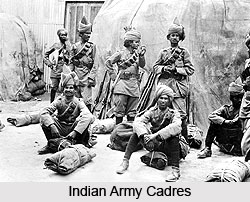 Indian Army after the First World War witnessed several major changes. After the First World War the Indian Army was reorganised for improving the system of command; achieving better balance between the services and fighting arms and for updating arms and equipment in order to develop a system of uninterrupted support and expansion during war period. As a result of the recommendations of the Esher Committee (1919) and the great impetus given to them by General Lord Rawlinson the re-organisation of the army again started. The most important of these reforms was that the feeding, clothing and housing of the Indian troops also was taken over by the Government. The terms of service were also improved. More Indian troops were posted to the British units and the two inter-mingled more and more except in the British and Indian cavalry. The Indian Tank Corps continued to be one class unit in so far as the other ranks were concerned.
Indian Army after the First World War witnessed several major changes. After the First World War the Indian Army was reorganised for improving the system of command; achieving better balance between the services and fighting arms and for updating arms and equipment in order to develop a system of uninterrupted support and expansion during war period. As a result of the recommendations of the Esher Committee (1919) and the great impetus given to them by General Lord Rawlinson the re-organisation of the army again started. The most important of these reforms was that the feeding, clothing and housing of the Indian troops also was taken over by the Government. The terms of service were also improved. More Indian troops were posted to the British units and the two inter-mingled more and more except in the British and Indian cavalry. The Indian Tank Corps continued to be one class unit in so far as the other ranks were concerned.
First World War, however, had shown glaring deficiencies in the organisation and administration of the army. Efforts to set these right now started in earnest. One of the biggest deficiencies had been recruitment system, training and maintenance of the reserves. This was sought to be set right by introducing a Regimental system. As a result, the Regimental system was introduced in the Indian infantry and all the battalions were linked together. Therefore, in 1922 the large and unwieldy single-battalion groups were reorganised into various regiments under Lord Rawlinton of Trent, the then Commander-in-Chief, wherein four or five erstwhile battalions from a certain ethnic region of India were amalgamating into a Regiment, with the 10th becoming a Training Battalion.
Each Regiment thus formed was given its own distinct dress code, badge, training centre, customs and traditions. Each Regiment was also allotted a number based on the seniority of its battalions since inception and, similarly, each battalion was given a sub-number. As a result the existing 131 battalions were integrated into the newly created 19 Infantry Regiments. Cavalry regiments were also linked together in groups. Artillery training centres were also formed for the supply of recruits and reinforcements for artillery units. Separate Corps of Signals and Ordnance were raised as also a Veterinary Corps. An Artillery Depot was established and steps were taken to introduce mechanised transport. Thus in 1922 the modern Indian Army came into being in terms of Regiments and Corps.
Even though retrenchment was being enforced it was ensured that the basic requirements of a modern army were kept in view. It was decided by the Legislative Assembly that India should maintain an army up-to-date in all respects. It was also decided to have armament of a similar pattern as held by the British and other European armies. Mechanical transport was accepted as an essential part of the equipment. Wheeled transport was still kept on an elaborate scale for the North West Frontier areas. The scale of automatic weapons for the infantry was also increased.
Four Commands were established which coincided with the areas of civil administration. Military administration was further decentralised and it was decided that the High Command should not deal with more than six subordinate commanders who were all to be of a high rank. The Northern Command with headquarters at Murree covered Punjab and North West Frontier Province. Western Command with headquarters at Quetta covered Sind, Rajputana and Baluchistan. Eastern Command from Nainital covered Bengal and United Provinces. The General Officer Commanding-in-Chief of each command who was a lieutenant general was made responsible for the command, administration, training and general efficiency of his troops as also the internal security of the area. For ease of administration the troops were equitably distributed to the four Commands and were divided into Covering Troops, Field Army and Internal Security Troops. The Covering Troops were meant to deal with minor frontier out-breaks and in case of large scale operations to form a Screen so as to allow mobilisation to proceed unobstructed. The Field Army consisted of four divisions and five cavalry brigades.
Soon after the First World War, frequent small operations were under taken to deal with the raiders and local tribesmen from across the North -West Frontier. The Indian Army, which looked for a period of peace, found it pitted against the Afghan Army which had crossed the border, and thus began the Third Afghan War. The Afghans were soon forced back across the border and the war came to an end on 8th of August 1919. Regular shifting and changes continued during the period in between the two wars. The Western Command was abolished in 1938. In 1939 the strength of the army was 182,000 and consisted of Indian units, British units, Auxiliary Force, Territorial Force and the University Training Corps.




















